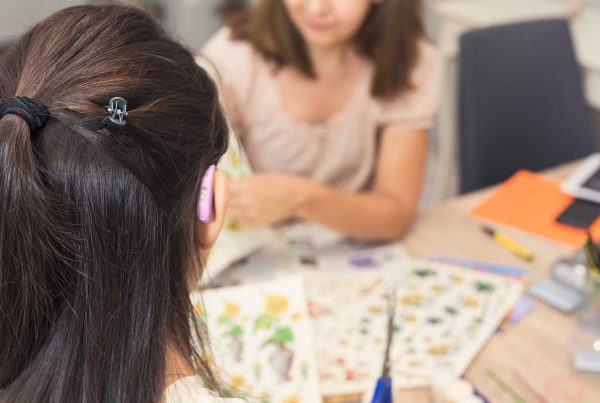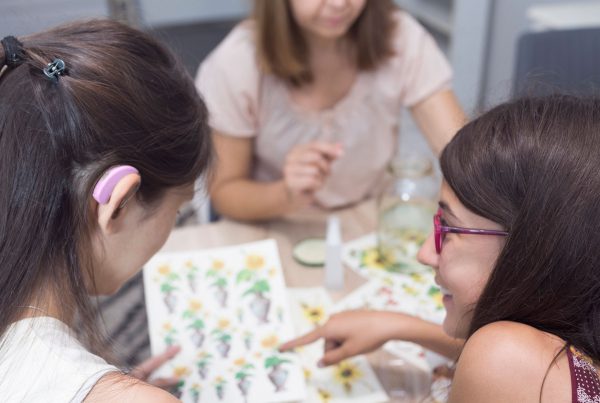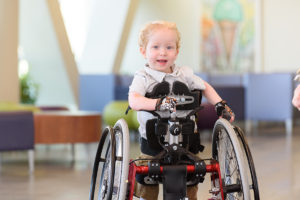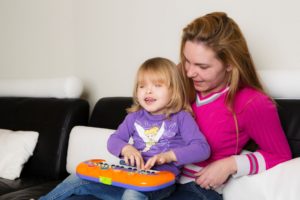The Needs and Rights of Children Who Are Blind or Visually Impaired
Prepared by the XIVth International Seminar on Preschool Blind June 1990
The impact of vision loss on the child and family must be understood and addressed.
Lack of vision limits much of a child’s ability to:
- know where he is and how to move from place to place.
- imitate and interact socially.
- understand what causes things to happen.
Children learn to play with others by watching, moving close to the action, and then joining in the game. A child who cannot see others playing, who doesn’t know how to move closer to them, and who has no way to find out how the game is played, often becomes isolated. As a result, this child may be perceived as withdrawn or developmentally delayed. Special training is required to understand the role that vision plays in development and to master the techniques for teaching the skills that deal with the effects of blindness and visual impairment.
Children who are blind or visually impaired and their families require early intervention services.
Childhood blindness or impairment has an impact on the entire family system. Services should begin as soon as a vision problem is diagnosed in order to encourage a child’s development and to prevent or minimize secondary conditions such as withdrawal, stereotypic behaviors (for example, eye poking, rocking), school failure and family stress.
Children who are blind or visually impaired and their families have a right to qualified instructors and specialists.
The people specifically trained to provide educational services to a child who is blind or visually impaired are:
- Teachers of the visually impaired.
- Orientation and mobility instructors.
Children who are blind or visually impaired and their families have a right to appropriate special services and instruction.
The following services must be integrated into a program that promotes independence for each child.
- Cognitive development opportunities (learning basic concepts, problem solving skills)
- Communication skills instruction (listening, turn-taking, personal expression, braille readiness)
- Gross and fine motor training (developing physical control and stamina)
- Low vision training (learning to use vision)
- Orientation and mobility instruction (learning to move independently in the environment)
- Parent education and family support (developing understanding, skills, and the ability to access personal and community resources)
- Recreation opportunities (enhancing creativity and enjoyment)
- Sensory training (learning to use the senses)
- Social skills instruction (learning skills for daily living and relationships)
What You Should Know About Blindness and Visual Impairment in Children
- The development of the child who is blind or visually impaired is highly individual, as it is with all children.
- Vision is the primary learning modality and source of information for most children.
- No other sense can stimulate curiosity, integrate information or invite exploration in the same way, or as efficiently and fully, as vision does.
- The child who is blind or visually impaired has many needs in common with all children. Among these are the needs for a sense of worth and accomplishment.
- Children who are blind cannot learn to do things by visual imitation. Children who are blind or visually impaired often require more “hands-on” experience, time, practice, and guidance in order to learn skills.
- More efficient hearing and a finer sense of touch, smell or taste do not develop automatically in an infant who is blind or visually impaired.
- Specialized training in the effective and efficient use of vision, hearing, touch, smell and taste can bring about increased skill in their use.
- Because most parents have not had the opportunity to know a child who is blind or visually impaired, they can often benefit from the assistance provided by trained professionals and other parents who have had such an experience, and adults who are blind or visually impaired.
- Many children who are blind or visually impaired have other disabilities.
- The relationship between blindness and other disabilities is complex. Assessment and programming become complicated and may require the services of a variety of disciplines.
- Instruction specific to their disability is essential for young children who are blind or visually impaired in order to meet their unique developmental needs.
The Opportunity To Be Equal
The opportunity for an equal education for blind and visually impaired students depends on the skills of qualified teachers, the availability of appropriate books and materials, plus providing the time needed for students to participate in specialized learning experiences.
Our local schools are fully prepared to meet the challenge of offering students without disabilities an equal opportunity to learn. But are they equally prepared and equipped to provide the same opportunity to learn to students who are blind and visually impaired?
In many cases, local schools have the specialized teachers, the adapted materials and books, and provide the instructional time needed for blind and visually impaired students to have an equal opportunity to learn. However, what if no qualified teacher of visually impaired students is available, or if not enough qualified teachers are available to meet all of the needs of the blind and visually impaired students. Will these students still have an equal opportunity to learn? And is an equal opportunity to learn being afforded to a student who needs ten hours of instruction weekly from a qualified teacher to learn braille but receives only one hour of instruction weekly?
At the Southern Oregon E.S.D. Program for the Visually Impaired, we believe that the opportunity for an equal education means that blind and visually impaired students must be provided learning experiences that are comparable to the learning experiences provided for sighted students.
- Vision loss permanently impacts learning, creating barriers that require specific solutions
- Students with a visual impairment are a diverse group
- Factors such as amount of vision loss, age of onset; and the presence or absence of other disabilities create the diversity.
- Literacy requires adaptation of media and specialized reading instruction.
The Right To Be Different
Offering an equal learning opportunity for blind and visually impaired students requires providing different educational materials and teaching methods than those provided for students without a disability. For example, blind and visually impaired students require a different reading medium: either braille, large print, or regular print with the assistance of an optical device. Also, students learning to read braille require completely different instructional strategies and teaching techniques than those that students learning to read print require. Even the manner in which blind and visually impaired students learn simple concepts such as large and small; tall and short; and hot and cold is different from how sighted students learn these concepts.
As educators, we know that a vision loss profoundly impacts learning. But we know that the impact on learning doesn’t need to result in a delay in. or a lack of educational opportunity. And we know what makes the difference: having qualified teachers, using very special materials and equipment, and providing sufficient instructional time for students to learn. These conditions are requirements for blind and visually impaired students to achieve the same educational results as sighted students achieve without adaptations.
Blind and visually impaired students must have the right to be different: to read in a different medium, to use devices to assist them in traveling through their environment, to use different materials, and to learn through different instructional methods. Blind and visually impaired students are entitled to an opportunity for an equal education. And they have a right to receive that education in a different manner, with different techniques, and in different educational settings.
 Autism Spectrum Disorder
Autism Spectrum Disorder
 Deaf and Hard of Hearing Services
Deaf and Hard of Hearing Services

 Services for Orthopedically Impaired Students
Services for Orthopedically Impaired Students Vision Impaired
Vision Impaired Traumatic Brain Injury Services
Traumatic Brain Injury Services